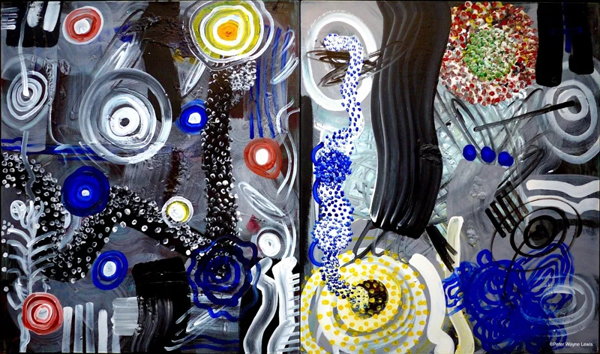
Peter Wayne Lewis, Event Horizon (2015), acrylic on Linen, diptych (overall 272x462 inches). Courtesy of Peter Wayne Lewis
To get to the Beijing studio where Peter Wayne Lewis has worked since before Obama became president, you drive northeast. You leave the city on the road that used to transport dignitaries and tourists out toward the airport, once a corridor lined by birch trees painted white to shoulder height, now widened into something closer to a highway, though always at grade, punctuated by intersections that still retain a slight whiff of the countryside they have replaced. You turn left in front of an Argentinian barbecue restaurant, probably defunct, called El Obelisco after the ornament in its forecourt. You pass some international schools and some of the original developments of American-style single-family houses, known as villas in Chinese, that began popping up on what were the city’s far fringes in the early 1990s, gated havens for expats and the newly rich. And then things start to fade. Suddenly the electric scooters and improvised delivery vehicles start to outnumber the cars, and cheap aluminum entrance archways announcing the names of villages begin to appear on either side of the street—villages that were once home to artists, and are now being flattened, brought into the larger machinations of the metropolis.
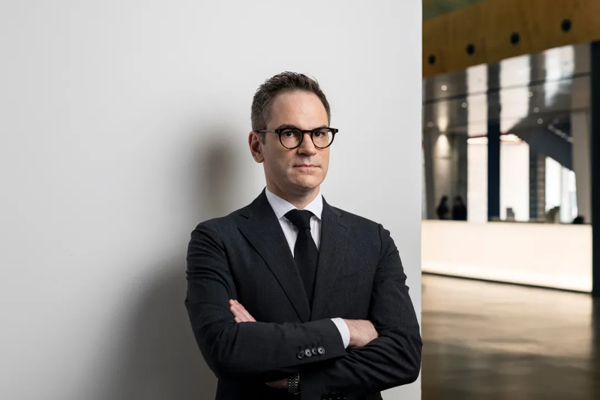
Philip Tinari’s portrait. Photo by Stefen Chow. Courtesy UCCA Center for Contemporary Art
You turn right just past the Red Brick Museum, a sprawling contemporary art center built by a provincial developer with avant-grade sympathies. You pass the Green T House, one of Beijing’s first high-concept Chinese restaurants when it was still in the diplomatic quarter at the turn of the millennium, now occupying a palace pavilion at the center of a yard of white gypsum gravel, a good place for a car show or a film shoot. And you enter the 318 Compound, a warren of brick- walled, aluminum-roofed studios where artists, mostly Chinese, have been making work just beyond the notice of the neighbors nearby or the city beyond. It is not the first place you might expect to meet the son of a Kingston jazz pianist, or for that matter, a senior professor from a storied Massachusetts art school. And yet entering Lewis’s studio on a muggy summer afternoon, or a pitch-black winter evening, you know this is where his particular breed of magic happens.
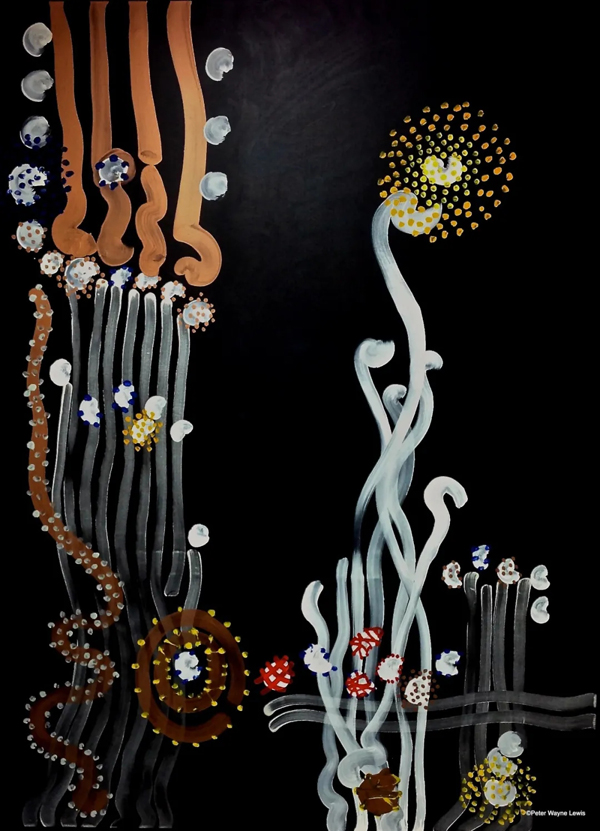
Peter Wayne Lewis, Brain Dance (2014), acrylic on linen, 90x66 inches. On view at 2021 AfriKin Art Fair: The Fire Next Time. Courtesy of Peter Wayne Lewis
Peter Wayne Lewis paints with the urgency of a man who has a story to tell. “Painting,” he says, “is an emergency.” His are abstractions somehow beyond expressionism, not color fields but force fields: canvases—alone, in pairs, in gridded suites—that don’t so much stage narratives as capture energies. The explorations are gestural, chromatic, formal, and somehow still true to life. “Mimesis is not what my paintings are about. I’m not looking outside I’m looking inside. I’m trying to discover and assign meaning to my own works. I’m trying to understand what they are, where they came from but they are my blood, my bones, everything I am.”
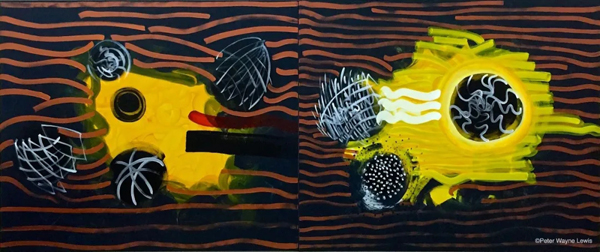
Peter Wayne Lewis, Laniakea (2015), acrylic on linen, diptych (overall 72x170 inches). Courtesy of Peter Wayne Lewis
Like many modern artists working in the African-American tradition, Lewis sees himself as a witness to diaspora, and an embodiment of the lived forces of power and capital that brought him into being. From this particular historical predicament, he seeks transcendence in a particular type of concourse with with creative urges from prehistory to the present, as mediated by the flesh. “I’m asking how to unlock or unpack what’s inside my body, how to find the languages embedded in my DNA. The double helix is the conduit to all of human history.” As he works, always to music, he thinks about the mystical roots of non-referential mark-making, far back in Africa, and deep inside himself: A path of meaning from Lascaux to Accra, Pollock to Rothko, Kingston to New Orleans, Bada Shanren to Leonardo, San Francisco to Boston, and onward to Beijing.
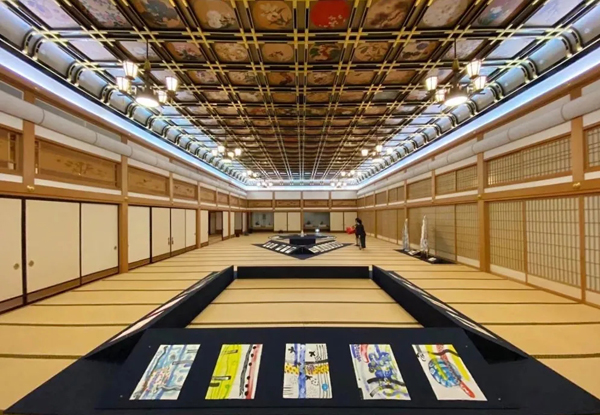
Peter Wayne Peter, the installation view of Buddha Plays Monk series in the In Praise of Zen at Tatami Museum Of Art (Japan). Courtesy of Peter Wayne Lewis and Tatami Museum of Art
What sets Lewis’s painting apart—aside from its distinctive motifs and colors, and the gestures that produce them—is its sense of deep time. Inspired by music, he understands the act of putting brush to canvas as on that exists in, and ultimately documents, the seconds, minutes, hours of its creation. These hours more often than not fall in the middle of the night. Living above his studio in the depths of Beijing’s summers and winters, he works unbothered until three or four a.m. in an emergency of his own making. In a city where oil pigments can be of dubious quality, he works in acrylic, slowing its drying time down to days: “I try to be as clear as I can about what each material might offer,” he says. The resulting compositions betray this intention toward, as his most accomplished suite to date calls it, “Bending Time.” And yet they also bend ideas of space. For these are paintings made by moving around, in circles, hovering two or three feet above the plane, canvases arrayed at first at random, ultimately into gridded groupings where patterns emerge, and formal and chromatic ideas jump from one square to another. “Space seems flat, but it’s not empty, it’s actually full,” Lewis told me over coffee in the haunt across from my office where he comes to refuel in the afternoons before he goes on another painting binge. “We do not exist if the space around us isn’t there.”
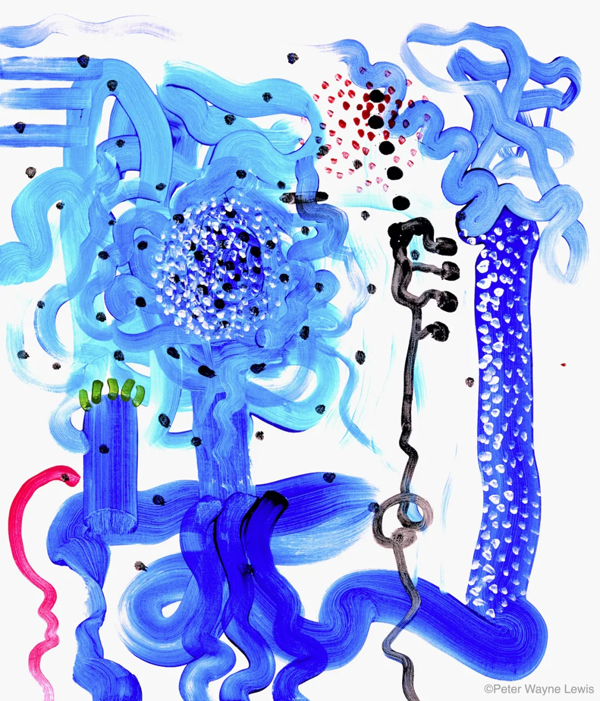
Peter Wayne Lewis, Buddha Plays Monk Suite #6 (2012), acrylic on linen, 42x36 inches. On view at 2021 CONTEXT Art Miami, Buddha Plays Monk Suite #6 is represented by John William Gallery. Courtesy of Peter Wayne Lewis
But why Beijing, and why now? I first met Lewis in 2010, at an opening dinner at the museum I have directed for the last eight years. We were celebrating an exhibition by Kehinde Wiley, the black artist who would go on to immortalize in an official portrait the black president who had just been elected, in the same galleries where Lewis’s solo exhibition “Beijing Boosters” would unfold in 2016. Kehinde Wiley or Peter Wayne Lewis having a studio in Beijing made a certain kind of sense in the logic of that late summer of US-China goodwill, back when the seeds of today’s new populism and authoritarianism were being planted without our quite yet realizing. Lewis then ran with a crowd that represented a new internationalism on the ground in the Chinese capital, organizing shows, discussions, gatherings, and galleries of their own. Perhaps we all suspected that it wouldn't last forever; but changes in geopolitical circumstance certainly didn’t keep him from continuing to do his work here. In the decade since, he has gone from the harbinger of a new order that never quite arrived, to the testament of an optimism that still somehow exists. If his work has not taken explicit turns of form or subject in response to the situation on the ground in China, it nonetheless reveals the subtle inflections of terroir: unanticipated changes of color, echoes and scents of the bustling village of Hergezhuang beyond the studio door, and an ineffable sense of another great cultural tradition finding its way into the artist’s consciousness.
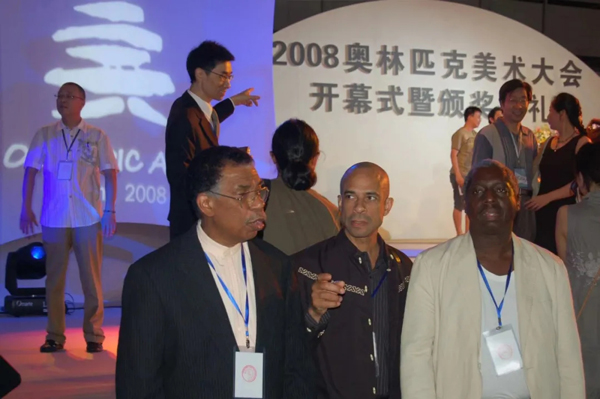
Peter Wayne Lewis, 2008 Olympic Fine Art in 2008, professor Kofi Kayiga, professor Peter Wayne Lewis, professor Bryan McFarlane (from Left to right). Courtesy of Peter Wayne Lewis
In the end, art for Peter Wayne Lewis is less about reflecting an environment or conveying a program than about what he has called “transformation of self into spirit through the ritual act of painting.” Painting is for him a form of magic, wrought with canvas, pigment, brush, and body, leaving behind palimpsests that will continue to testify long after he, and we, have gone. It offers a way, unique and inescapable, of convening with the expressions of humanity throughout the millennia. It allows for an embrace of the deeply ordered chaos that engulfs us. And most importantly, it drives the artist on a never-ending journey of discovery and reinvention. “I don’t know how I make these paintings,” Lewis has said. “I’m always in awe.”

Philip Tinari is an American writer, critic, art curator, and expert in Chinese contemporary art. Based in Beijing since 2001, Tinari is currently director and CEO of the UCCA Center for Contemporary Art (UCCA) in Beijing. Tinari is the founding editor of LEAP Magazine, founding editor of the Chinese edition of Artforum, director of UCCA Center for Contemporary Art.


